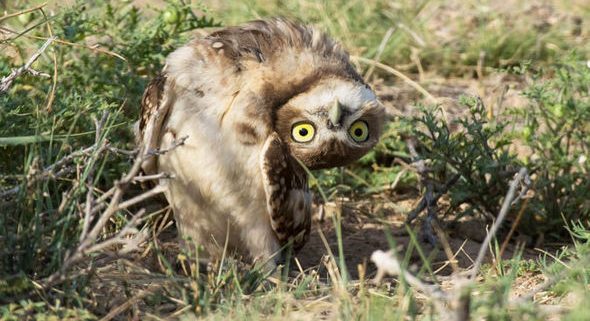Owls: 7 Facts About These Mysterious Nocturnal Creatures
Creatures shrouded in sheer mystery, owls may be cute and cuddly but don’t let their looks fool you. As not all owls are friendly or created equally, their temperaments and behaviour can be rather eccentric.
Just how you ask? Let our factual snippets on these birds unravel the unfamiliar and peculiar.
Owls Can Rotate Their Heads Nearly All Around – To Some Degree

Image Credit: Daily Express
You probably have heard that owls can rotate their heads 360 degrees but this is in fact a myth. Owls can only turn their necks 135 degrees in either direction, giving them 270 degrees of full body movement. What gives these nocturnal creatures such a useful trait? Scientists have pinpointed that down to their unique make-up of bone structure, blood vessels with contractile reservoirs and a reinforced vascular system. This allows them to turn their heads to such varying degrees without stopping the supply of blood.
They Possess A Heightened Sense Of Hearing

Image Credit: New Scientist
Capable of noticing prey under environmental layers such as dirt, plants, leaves and snow, owls have various hearing receptacles at differing heights on their heads that allow them to pinpoint prey based on minute differences in sound waves. What of owls with flat faces? They possess unique feathers that are sound focused, basically turning their faces into one large ear!
Owls Prey On Each Other Sometimes

Image Credit: Jongsun Lee, Unsplash
Compared to their smaller frame, owls often eat prey significantly larger than themselves or rather their own kind. Take the eagle owl for instance as they have been known to even target small deers! Or the great horned owl that enjoys attacking the barred owl which in turn preys on the Western screech-owl. This owl-on-owl predation cycle is one of the reasons why the Western screech-owl population is at an all-time low.
Their Markings Allow Them To Blend In Seamlessly Into The Environment

Image Credit: Instant Shift
Have you ever seen an owl sleeping in broad daylight? Chances are that you’ll find this feat especially difficult as they have mastered the art of camouflaging to a tee. Take the African Scops Owl for example. You’ll need to look twice to notice its hidden visage amidst the surroundings.
You Won’t Want To Be Around When They Start Hissing

Image Credit: The Ecologist
No we’re not talking about hooting, owls can also make a range of unique calls such as screeches, whistles and squeaks. Case in point? The barn owl when threatened often make hissing noises that will make the hairs on your back stand up. Truly the stuff of nightmares.
Owls Are Nature’s Answer To Pest Control

Image Credit: Victor Benard
A boon for farmers the world over, owls help keep the rodent population in check with sheer efficiency. Although masked in a small frame, a single barn owl family can eat up to 3000 rodents in just the space of four months! Many farmers practice the art of installing owl nesting boxes to attract owls to help keep out voles and gophers from their precious crops.
A single owl can consume 20 plus kilos of gophers in a just one year.
We Get Along With Them Rather Well

Image Credit: Emiichan Blog
Since ancient times, owls have remain ever popular with humans. Showing up in 30,000 year old cave paintings in France and Egyptian hieroglyphs, Falconers have also been known to use owls during the Middle Ages. Although they are illegal to be kept as pets in many countries, their popularity remains on the rise. In Japan, it’s not uncommon to stumble upon owl cafes, where you can take pictures and even pet these furry birds!



